Förster Resonance Energy Transfer#
Calculate and plot phasor coordinates of FRET donor and acceptor channels.
The phasorpy.phasor.phasor_from_fret_donor(),
phasorpy.phasor.phasor_from_fret_acceptor(), and
phasorpy.plot.PhasorPlotFret functions and classes
are used to calculate and plot phasor coordinates of
FRET (Förster Resonance Energy Transfer) donor and acceptor channels
as a function of:
laser pulse or modulation frequency
donor and acceptor lifetimes
FRET efficiency
fraction of donors undergoing FRET
fraction of directly excited acceptors (acceptor bleedthrough)
fraction of donor fluorescence in acceptor channel (donor bleedthrough)
fraction of background fluorescence
Define FRET model settings used throughout this tutorial:
settings = {
'frequency': 60.0, # MHz
'donor_lifetime': 4.2, # ns
'acceptor_lifetime': 3.0, # ns
'fret_efficiency': 0.5, # 50%
}
FRET efficiency trajectories#
The lifetime \(\tau_{DA}\) and fluorescence intensity \(F_{DA}\) of a FRET donor quenched by energy transfer of efficiency \(E\) is given by \(\tau_{DA} = \tau_{D} (1 - E)\) and \(F_{DA} = F_{D} (1 - E)\), where \(\tau_{D}\) and \(F_{D}\) are the donor lifetime and intensity in absence of energy transfer.
Hence, in the absence of background fluorescence and donors not undergoing energy transfer, the phasor coordinates of the donor channel at different FRET efficiencies lie on the universal semicircle. At 100% energy transfer, the donor lifetime and fluorescence intensity are zero.
The sensitized emission of a FRET acceptor is phase-shifted and demodulated relative to the FRET donor because of the duration of, and dissipation during, relaxation and energy transfer processes. Hence, in the absence of directly excited acceptor, donor bleedthrough, and background fluorescence, the phasor coordinates of the acceptor channel at different FRET efficiencies lie outside the universal semicircle of the donor.
from phasorpy.plot import PhasorPlotFret
PhasorPlotFret(
**settings,
title='FRET efficiency trajectories',
).show()

Fractions not FRETing#
Adding fractions of donors not participating in FRET and fractions of directly excited acceptors (acceptor bleedthrough) pulls the FRET trajectories of the donor and acceptor channels towards the phasor coordinates of the donor and acceptor without FRET:
PhasorPlotFret(
**settings,
donor_freting=0.9, # 90%
acceptor_bleedthrough=0.1, # 10%
title='FRET efficiency trajectories with fractions not FRETing',
).show()
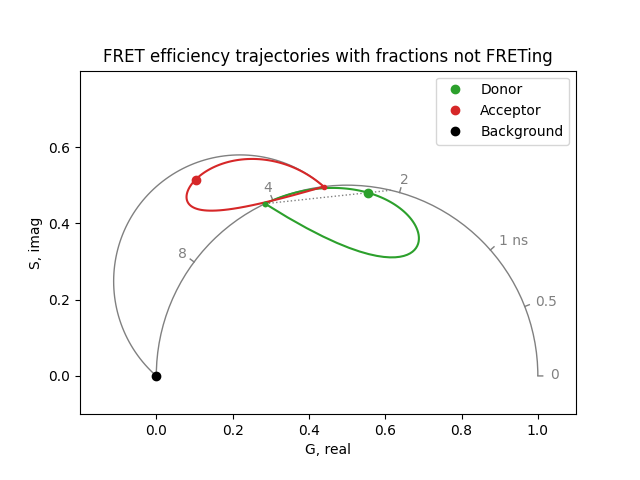
Donor bleedthrough#
If the acceptor channel contains fractions of donor fluorescence (donor bleedthrough), the FRET efficiency trajectory of the acceptor channel is pulled towards the phasor coordinates of the donor channel:
PhasorPlotFret(
**settings,
donor_bleedthrough=0.1, # 10%
title='FRET efficiency trajectories with donor bleedthrough',
).show()
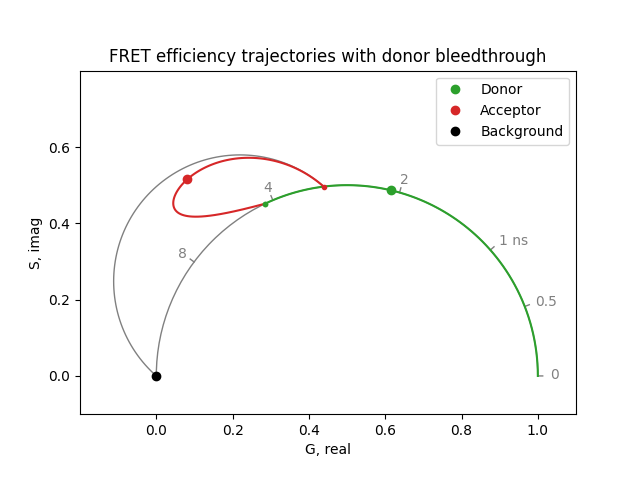
Background fluorescence#
In the presence of background fluorescence, the FRET efficiency trajectories are linear combinations with the background phasor coordinates. At 100% energy transfer, the donor channel only contains background fluorescence if all donors participate in FRET. At 0% energy transfer, in the absence of donor bleedthrough and directly excited acceptor, the acceptor channel only contains background fluorescence:
PhasorPlotFret(
**settings,
donor_freting=1.0,
acceptor_background=0.1, # 10%
donor_background=0.1, # 10%
background_real=0.5,
background_imag=0.2,
title='FRET efficiency trajectories with background',
).show()
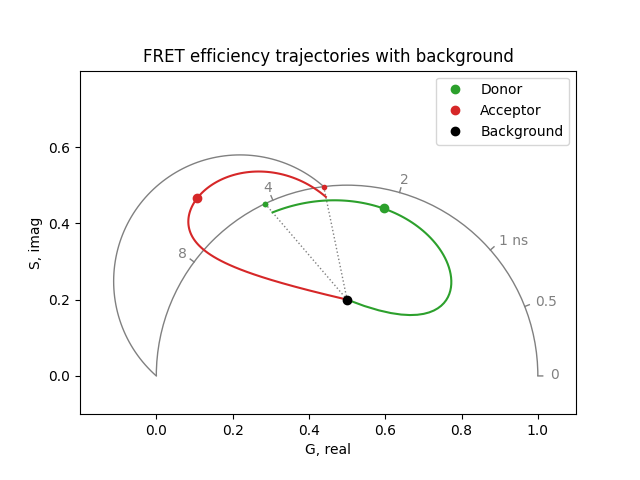
Many parameters#
The phasor coordinates of the donor channel may contain fractions of:
donor not undergoing energy transfer
donor quenched by energy transfer
background fluorescence
The phasor coordinates of the acceptor channel may contain fractions of:
acceptor sensitized by energy transfer
directly excited acceptor
donor bleedthrough
background fluorescence
PhasorPlotFret(
**settings,
donor_freting=0.9,
donor_bleedthrough=0.1,
acceptor_bleedthrough=0.1,
acceptor_background=0.1,
donor_background=0.1,
background_real=0.5,
background_imag=0.2,
title='FRET efficiency trajectories with many parameters',
).show()
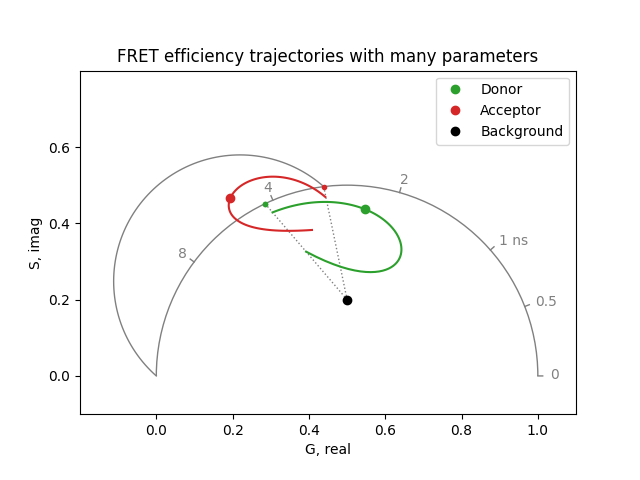
Interactive plot#
Run the FRET phasor plot interactively:
$ python -m phasorpy fret
or
PhasorPlotFret(
**settings,
donor_freting=0.9,
donor_bleedthrough=0.1,
interactive=True,
title='Interactive FRET phasor plot',
).show()
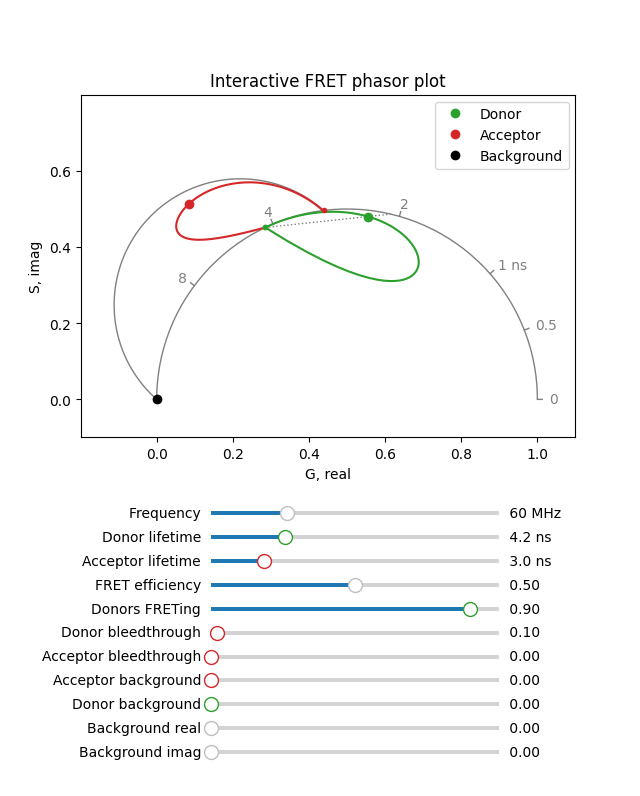
Multi-frequency plot#
Since the components of the FRET model have different frequency responses, the multi-frequency plots of donor and acceptor channels may show complex patterns. Background fluorescence is omitted from this example to model an in vitro experiment:
import numpy
from phasorpy.phasor import (
phasor_from_fret_acceptor,
phasor_from_fret_donor,
phasor_to_polar,
)
from phasorpy.plot import plot_polar_frequency
frequency = numpy.logspace(0, 4, 64).reshape(-1, 1) # 1-10000 MHz
fret_efficiency = numpy.array([0.05, 0.95]).reshape(1, -1) # 5% and 95%
donor_lifetime = 4.2
acceptor_lifetime = 3.0
donor_freting = 0.9
donor_bleedthrough = 0.1
acceptor_bleedthrough = 0.1
donor_real, donor_imag = phasor_from_fret_donor(
frequency,
donor_lifetime,
fret_efficiency=fret_efficiency,
donor_freting=donor_freting,
)
# phasor of acceptor channel
acceptor_real, acceptor_imag = phasor_from_fret_acceptor(
frequency,
donor_lifetime,
acceptor_lifetime,
fret_efficiency=fret_efficiency,
donor_freting=donor_freting,
donor_bleedthrough=donor_bleedthrough,
acceptor_bleedthrough=acceptor_bleedthrough,
)
plot_polar_frequency(
frequency,
phasor_to_polar(donor_real, donor_imag)[0],
phasor_to_polar(donor_real, donor_imag)[1],
title='Donor channel',
)
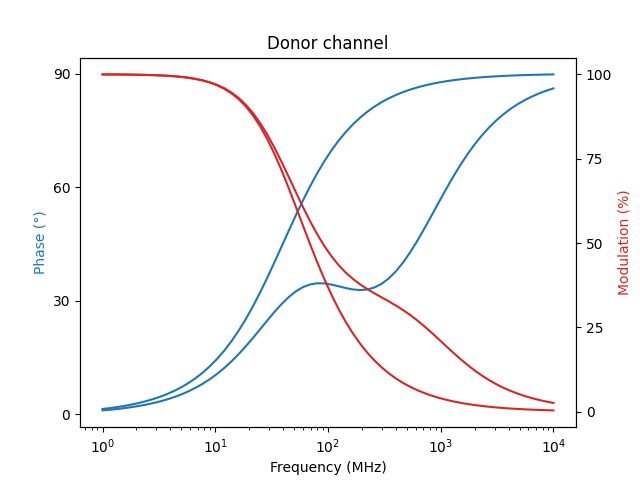
plot_polar_frequency(
frequency,
*phasor_to_polar(acceptor_real, acceptor_imag),
title='Acceptor channel',
)
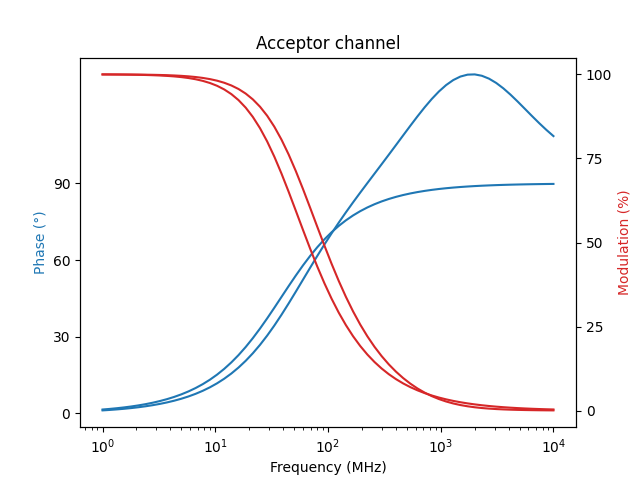
sphinx_gallery_thumbnail_number = 5 mypy: allow-untyped-defs, allow-untyped-calls mypy: disable-error-code=”arg-type”
Total running time of the script: (0 minutes 1.778 seconds)
